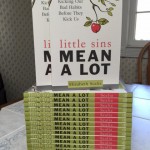I am about to start a conspiracy theory.
It has nothing to do with the gold standard. I’m too poor to know or care much about that. The moon landing? Forget it. The last guy who tried that got punched by Buzz Aldrin. I may be a fool, but I’m not that kind of fool.
No, this has to do with something that affects my life very directly and profoundly, something I deal with every day. It has to do with the proper placement of a comma or period vis-a-vis quotation marks.
In Slate, Ben Yagoda warns that the right and proper way — the god-fearing American way — which places the punctuation marks neatly inside the inverted commas, is slowly yielding to the heathen English way, which kicks them outside:
The British style also rules on message boards and bulletin boards. I scanned four random posts in Metafilter.com (about Sony Playstation’s hacking problems, the death of Phoebe Snow, the French police, and cool dads) and counted nine comments with periods and commas outside, seven inside.
I spotlight the Web not because it brings out any special proclivities but because it displays in a clear light the way we write now. The punctuation-outside trend jibes with my experience in the classroom, where, for the past several years, my students have found it irresistible, even after innumerable sardonic remarks from me that we are in Delaware, not Liverpool. As a result, I have recently instituted a one-point penalty on every assignment for infractions. The current semester is nearing its end, but I am still taking points away.
Why has this convention become so popular? I offer two reasons, one small and one big. The small one is a byproduct of working with computers, and writing computer code. In these endeavors, one is often instructed to “input” a string of characters, and sometimes (in the printed instructions) the characters are enclosed in quotation marks. Sticking a period or comma in front of the closing quotation marks could clearly have bad consequences. So, for example, the Chicago Manual of Style (16th edition), which otherwise endorses the American way— “This is a traditional style, in use well before the first edition of this manual (1906)”—makes an exception in the case of computer instruction, illustrated by:
name your file “appendix A, v. 10”.
But the main reason is that the British way simply makes more sense. Indeed, since at least the 1960s a common designation for that style has been “logical punctuation.” The best way to grasp this is to look at an example, such as what Slate commenter Dean Hamer wrote under a recent article about PBS and NPR:
[I]ronically, given the anecdote about “Tales of the City”, PBS is the ONLY widely available channel that has any serious LGBT content; e.g. documentaries such as “Ask Not” and “Out in the Silence”.
“Tales of the City” and “Out in the Silence” are units—consisting of the words and the quotation marks. Insinuating a period or comma within the unit alters it in a rather underhanded manner. American style is inconsistent, moreover, because when it comes to other punctuation marks—semicolons, colons, exclamation points, question marks, dashes—we follow British/logical protocol. Dean Hamer would pass muster in any U.S. newspaper or magazine, for example, if he were to write: I am a big fan of “Tales of the City”; did anyone else see “Ask Not”?
If it seems hard or even impossible to defend the American way on the merits, that’s probably because it emerged from aesthetic, not logical, considerations. According to Rosemary Feal, executive director of the MLA, it was instituted in the early days of the Republic in order “to improve the appearance of the text. A comma or period that follows a closing quotation mark appears to hang off by itself and creates a gap in the line (since the space over the mark combines with the following word space).” I don’t doubt Feal, but the appearance argument doesn’t carry much heft today; more to the point is that we are simply accustomed to the style.
“Hard to defend on its merits”? Since Yagoda’s obviously an Anglophile, he should understand what I mean when I say that punctuation is like an aristocracy: impossible to defend on its merits, but at its best, a source of good taste, even panache. Let your eye take in the two styles. With the punctuation tucked in discreetly, the American style looks neater. More than that, in its resemblance to a baby chick nestling beneath its mother’s wing, it evokes a feeling of order and security. With the punctuation left to flap in the breeze like a red flag off a flatbed, or the surrender flag at Yorktown, the English style bespeaks uncertainty and chaos.
For another example of illogic in the service of elegance, consider the semicolon; strictly speaking, you almost never have to use one. If you wanted to, you could get by 99% of the time alternating periods and commas. In fact, Kurt Vonnegut once advised readers to do just that, damning semicolons as “transvestite hermaphrodites representing absolutely nothing.”
For Vonnegut, primitive that he was, that was absolutely true. But for the rest of us, who like to thrill readers with the occasional hairpin, conjunction-less turn from one independent clause into another, they come very much in handy. They’re like em dashes — pieces of flair no writer should overuse, but which he should never be expected to live without.
But — again, in Slate — Paul Collins asks “Has Modern Life Killed the Semicolon?”
The semicolon has spent the last century as a fussbudget mark. Somerset Maugham and George Orwell disdained it; Kurt Vonnegut once informed a Tufts University crowd that “All [semicolons] do is show that you’ve been to college.” New York mayor Fiorello LaGuardia’s favorite put-down for egghead bureaucrats who got in his way was “semicolon boy.” And though semicolons have occasionally made news—tariff bills have imploded over their misplacement, and a 1927 execution hinged on the interpretation of a semicolon—the last writers to receive much notice for semicolon use have been a New York City Transit employee and the Son of Sam. In 1977 the NYPD speculated that “the killer could be a freelance journalist” because of his “use of a semicolon” in his taunting letters. (Decades later, columnist Jimmy Breslin still marveled that “Berkowitz is the only murderer I ever heard of who knew how to use a semicolon.”)
Do I have to sketch this out on a chalkboard? We’re seeing the migration of the comma outside the quotation marks — supposedly more logical than the alternative — at the same time as the gradual phasing out of the semicolon, which is seen, somehow, as both fussy and frivolous. I ask you, people (rhetorically, of course): Cui bono? Who stands to gain from this?
Actually, I have no idea. I’m a cruddy meme smith, as it turns out. But all of a sudden, I find I’ve gained a new sympathy for all those people who miss the Latin Mass.
UPDATE I: (From Elizabeth) Since we’re talking punctuation, let us once again celebrate the semicolon!
UPDATE II: Max just got his first instalanche!, congrats, Max and thank you, Glenn!











